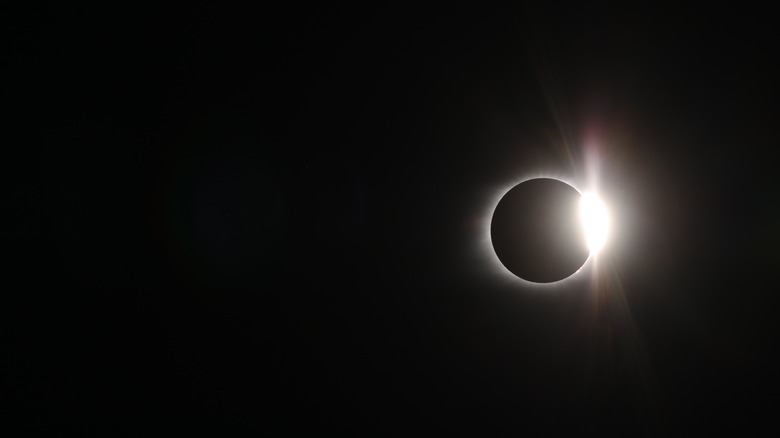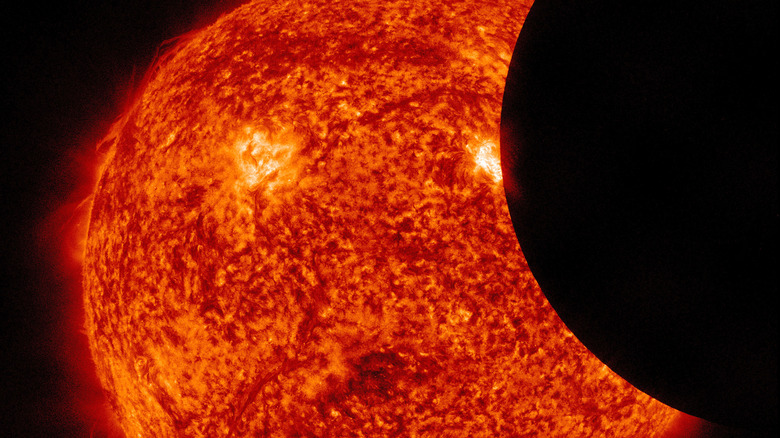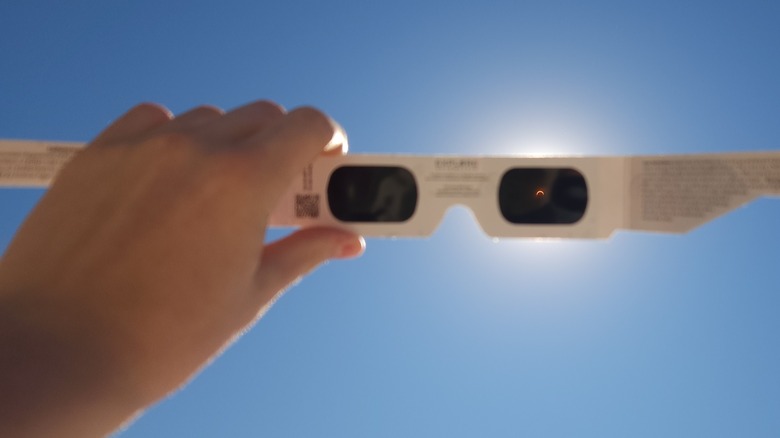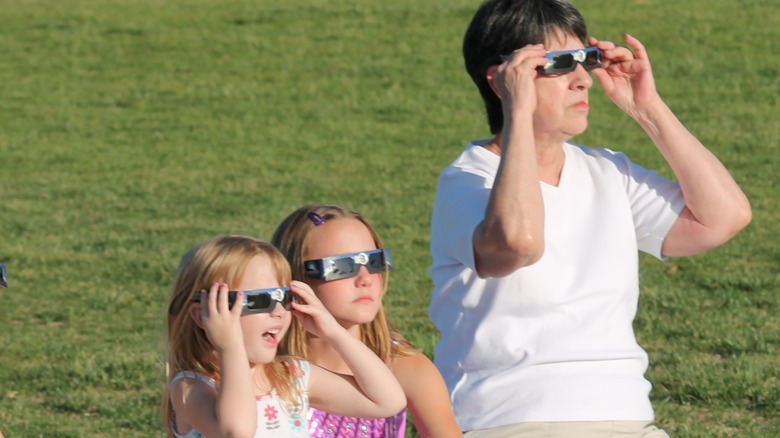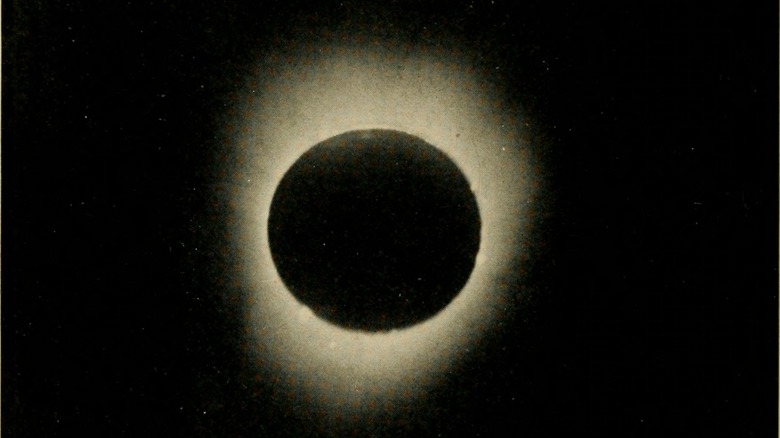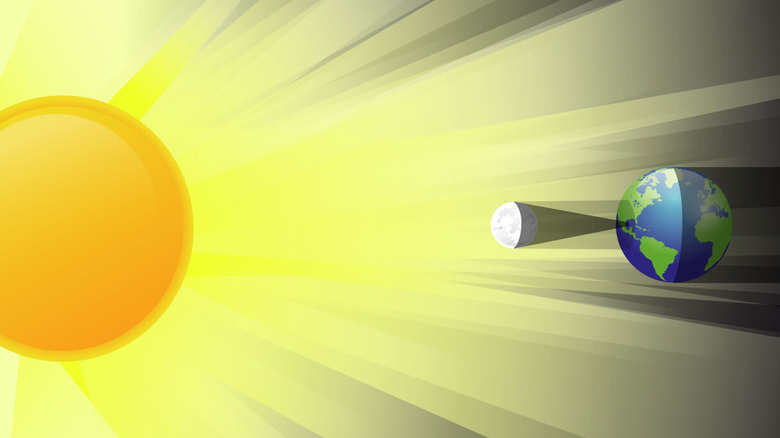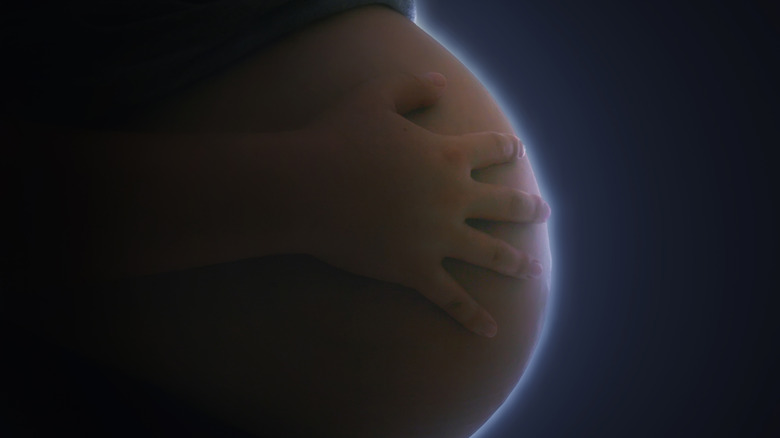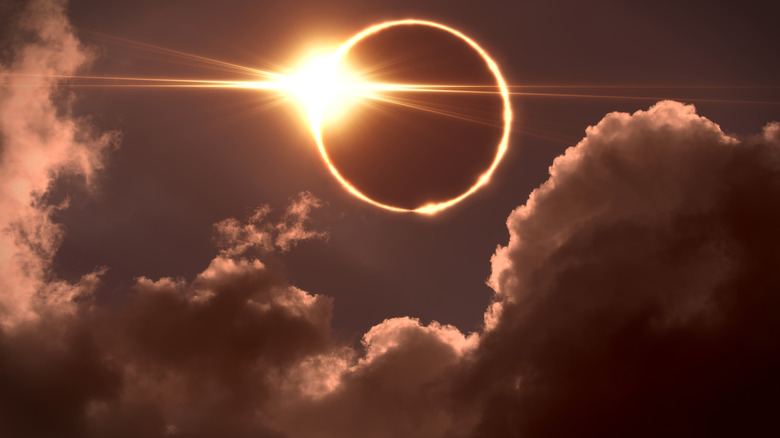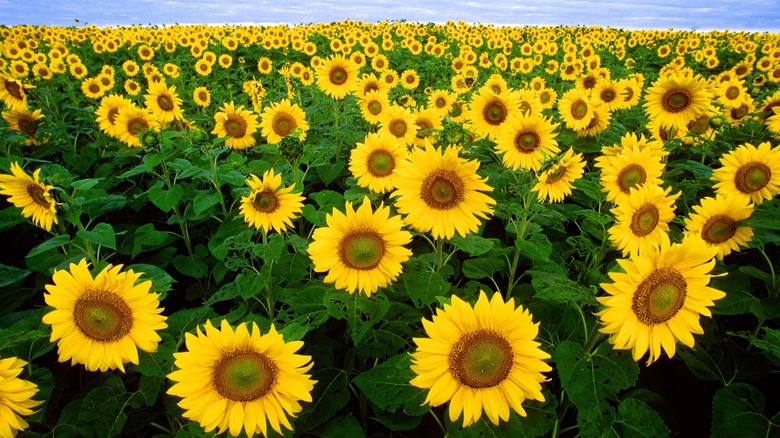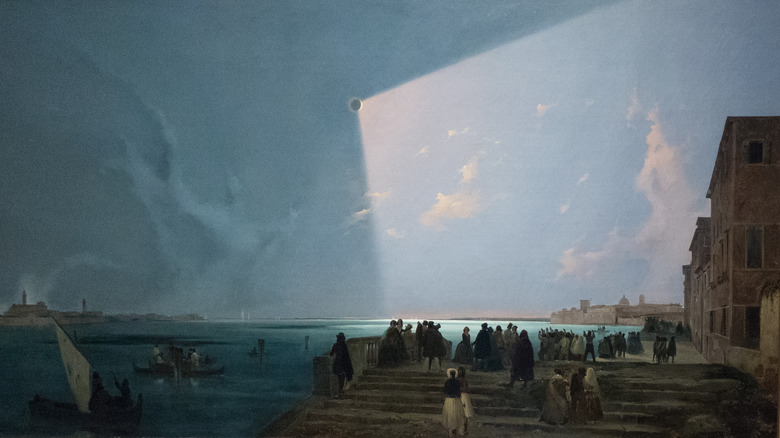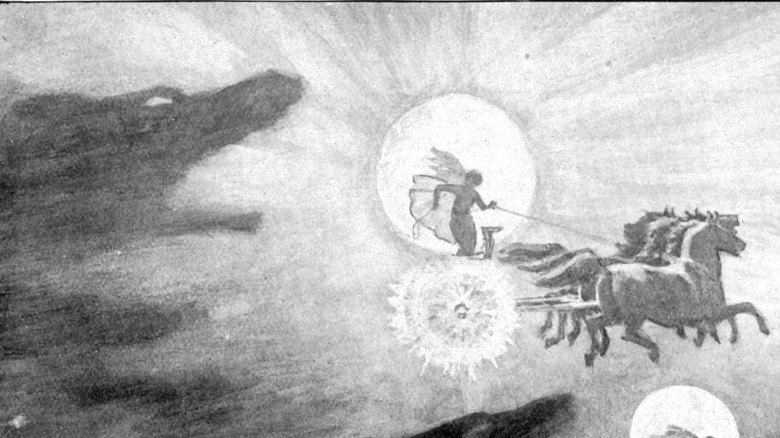False Facts About Solar Eclipses You Should Never Believe
Solar eclipses are thrilling, spectacular events. They only happen because of a wild, cosmic coincidence — namely that the moon is both about 400 times smaller and 400 times closer than the sun, and so when the moon's orbital path crosses the sun's, the moon's shadow causes parts of the Earth below to grow dark, while looking like the Sun and Moon are both the same size. Since darkness in the daytime is not part of the normal routine, eclipses have historically been seen as significant and even sinister.
Since ancient times, legends, myths, and superstitions have grown up around eclipses, and these beliefs have grown with the times: Ill effects of an eclipse that used to be attributed to demons or the wrath of gods is now credited to strange radiation. Are solar eclipses actually harmful? Are you allowed to look at them? Will they hurt your baby? Is a wolf going to eat the sun forever? There's a lot of common misinformation about solar eclipses that maybe even you — yes, you — believe.
False: The sun is more dangerous during an eclipse
The idea at the heart of most of the myths surrounding solar eclipses is the idea that the sun somehow becomes more dangerous during the process of an eclipse. The basic idea is that the light and radiation emitted from the sun is changed somehow by the moon moving into its path. While modern society is, generally speaking, past the idea that the darkness is forever and that the light will never return when an eclipse happens, some people may choose to stay inside either because of uncertainty about what this celestial event might bring with it, or just because it's kind of weird to be outside during an eclipse, as the shadows behave strangely and animal behavior changes from the routine.
But the fact is that there's no difference in the light or type of radiation that comes from the sun during an eclipse. The dangers from the sun in an eclipse are the same as they are on a non-eclipse day, which is to say there's not none, but there's not more. Wear sunscreen if you're going to be out, and use appropriate protection for your eyes if you're going to look up at the sun as the moon passes by. But you don't need to invest in a biohazard suit or call off work or anything. Plus, you should go outside and check it out because the lights and shadows are cool.
False: A solar eclipse can blind you
One specific kind of harm that people worry about when it comes to solar eclipses is that they can blind you if you look directly at them. This is related to the idea of the sun producing some kind of unique radiation during the eclipse. Part of the reason for this belief is that during totality — when the moon completely covers the sun — the sun's corona (the outermost part of the sun's atmosphere), which is usually too hard to see because of the light from the sun's surface, becomes visible. This electromagnetic radiation sometimes appears an eerie green, and so people believe that this radiation that can best be seen during an eclipse only appears during an eclipse, and that it can permanently damage your eyesight.
But what really happens if you watch an eclipse without glasses? In truth, this electromagnetic radiation from the corona is a million times weaker than normal sunlight and definitely doesn't have the power necessary to blind you, especially after traveling 93 million miles of space and being filtered by the Earth's atmosphere. The danger of looking at an eclipse comes from if you look up before the totality and you see the unblocked light of the sun. Looking directly at the sun can, in fact, cause damage to your retinas. So, you know, don't stare directly at the sun, eclipse or not. Even a short amount of exposure to direct sunlight can damage your eyes.
False: There's no safe way to look at a solar eclipse
Perhaps because of the dangers of looking at the sun in general, or because of the persistent myth that there is something particularly dangerous about a solar eclipse specifically, the belief spread that not only is it dangerous to look at an eclipse with the naked eye, but that there's no way to look directly at an eclipse at all without risking permanent damage to your eyes. The idea is that the only way to experience the eclipse is indirectly, through eclipse projectors, pinhole cameras, and other similar devices that project an image of the eclipse onto a surface that's safe to look at.
While it's unsafe to look at the sun even with the aid of everyday objects like sunglasses or photo negatives, it's definitely okay to look at an eclipse with those special solar-viewing glasses that everyone sells when an eclipse is on its way, which are much darker and have to meet certain safety standards. Additionally, welding glasses with a shade rating of 12 or higher are essentially the same as the commercially available eclipse glasses in terms of light filtering. And if you're in the viewing path of the total eclipse, it's actually completely safe to look at the totality without any kind of eye protection whatsoever. Just make sure it's a total eclipse, otherwise normal staring-at-the-sun consequences apply.
False: The moon turns completely black during an eclipse
If, by chance, you ever have had the opportunity to witness a total solar eclipse and see the sun blotted out by the shadow of the moon, the moon likely looked like an absolute void of darkness. You would see the black circle of the sun, the corona wriggling out around it, and then the dark of the sky. "How much more black could this be?" Nigel Tufnel of Spinal Tap might ask if he were there beside you, looking up at the totality from a camp chair. "The answer is none. None more black."
It turns out, though, that it could actually be more black. You know how the light of the sun reflects off the moon at night and creates moonlight? If you've ever seen photos from the moon landings, or even if you think about it for just a second, you probably know that the same thing happens with the Earth. Sunlight reflects off the Earth and creates what is called earthshine, which is very bright as seen from the moon. Even though the moon's shadow blocks the sun's light across the path of totality, the sun is still shining at full daylight on the rest of the Earth's surface, meaning the moon is seeing the Earth equivalent of a full moon. As a result, this earthshine reflects back onto the near surface of the moon with a pale white glow. It's just hard to see because the sun's corona shining around the outer edge of the moon is so much brighter.
False: There are never eclipses at the Poles
If you've ever learned about the cause of the different seasons on Earth, you probably know that the Earth's axis isn't straight up and down relative to its orbital path around the sun. Instead, the Earth's axis is tilted about 23.5 degrees compared to its orbit, meaning that different latitudes get different amounts of direct sunlight at different times of the year. Because of this axial tilt and how it affects the angle of the sun's rays hitting the Earth's surface, some people believe that the North and South poles are at such angles that there are never solar eclipses visible there.
But while it is true that eclipses in the polar regions don't get as many total eclipses as other places, there are a couple of good reasons for that; namely that there's just less land in polar regions for the path of totality to cross, and polar regions only get sunlight for half the year, meaning fewer opportunities for eclipses. Astronomically speaking, there's nothing keeping eclipses from happening at the poles. In fact, the last total eclipse seen from the North Pole was on March 20, 2015, and the last one in Antarctica was on November 23, 2003. If you want to see it to believe it, the next total eclipse at the South Pole will be in December 2039, so book your tickets across the Drake Passage now before it's all sold out.
[Featured image by National Optical-Infrared Astronomy Research Laboratory via Wikimedia Commons | Cropped and scaled | CC BY 4.0]
False: Eclipses are dangerous to pregnant women
In Mexico around the time that European colonizers were beginning to arrive, there was a belief in circulation that a solar eclipse could have harmful effects on a pregnant woman and her unborn fetus, leading to birth defects or even miscarriages. This belief, however, was not exclusive to early modern Mexico and in fact has persisted well into contemporary times. It has simply evolved from being understood to be some kind of cosmic curse to being thought to be caused by radiation from the sun. In this case, the culprit is neutrinos, tiny particles from the sun that are constantly hitting us like an invisible rain shower.
This belief is current enough that a pregnancy blog in 2012 highlighted how some Hispanic expectant mothers believed that if an eclipse was on the way, they should wear red underwear with a safety pin attached to protect the baby, or in the very least, tie a red ribbon to underwear of some other color. Once the baby is born, put an open pair of scissors under their bed to ward off neutrinos.
Perhaps needless to say, eclipses are harmless to both parent and unborn baby. Our bodies are being hit by trillions of neutrinos all the time, night or day, eclipse or not, and they are completely safe. Plus there's not much we could do to stop them if we wanted to, no matter what color our underwear is.
False: Eclipses poison food
The fear of some kind of unique solar radiation seeping out and bathing the Earth in its rays during a solar eclipse extends beyond retinas and wombs. There is a belief still in contemporary circulation that eclipses, solar or lunar, cause any food prepared during them to become poisonous. A more mystic and less scientific explanation for this danger as posed by some spiritual leaders suggests that eclipses trick the Earth by passing through an entire light/dark cycle much faster than usual, causing food to go bad immediately. So, either that or radiation.
However, if you give it a moment's thought, you'll realize that if there were toxic radiation hitting food on your stove, it would also be hitting food in your fridge, in your pantry, at the grocery store, on produce trucks, in the fields, and wherever foods are found. Nothing would be safe to eat, and the people of Earth would have to start agriculture over from scratch every time there was an eclipse. It's likely that superstitious associations between eclipses and food poisoning arose from a coincidental case happening at the same time as an eclipse followed by a bunch of confirmation bias by people expecting eclipse food to make people sick. Subscribers to this belief would then ignore the thousands of people in the path of totality who were able to enjoy a nice dinner at their eclipse party with no ill effect.
False: Eclipses help flowers grow
Not all superstitious beliefs about solar eclipses are negative, however. There is a belief in Italian folklore that eclipses are good luck where your garden is concerned. Anything planted during the event grows bigger, better, and more beautiful. However, there's no evidence that the light or radiation of the sun during an eclipse has any more impact on flowers or any other part of the environment than it does on humans and their lunches.
That's not to say that flowers aren't affected by eclipses at all. As you likely remember from science class, plants rely on sunlight for photosynthesis, the process by which they nourish themselves and grow. Some flowering plants are known to close their petals at night when there is no sunlight to absorb. These same plants — including the hibiscus and the morning glory — have been observed closing up during the totality of a solar eclipse like they would at night and opening again a few minutes later like they would in the morning. Likewise, animals are known to react in strange ways and the the sudden drop in light and temperature during an eclipse as if night had suddenly fallen. Some animals like horses and dogs tend to get spooked by eclipses, but there's no evidence of any plant or animal being genetically affected by an eclipse.
False: Eclipses are signs of impending misfortune
In a very broad sense, eclipses have been — and continue to be — seen as omens of ill fortune. For example, the Greek historian Herodotus records an incident where the Persian Xerxes interprets an eclipse as a sign that his enemies will be destroyed; the biographer Plutarch tells how the Athenian leader Pericles made fun of his soldiers when they panicked at the sight of an eclipse by making a shadow with his cloak and asking if that was an omen too. A number of other historical deaths and disasters have been said to have followed an eclipse. These and similar events have led people to believe eclipses to be signs that some disaster is coming. Some people believe that eclipses are at least signs of some major life change coming, good or bad. More specifically, some people believe that if an eclipse happens on your birthday or six months after your birthday, this is a portent of forthcoming bad health.
As with the poisoning myth, seeing eclipses as bad omens is the result of confirmation bias. Human brains look for patterns and consequently notice every time two things happen at the same time and ignore every time they don't. Eclipses aren't that rare; there are multiple eclipses every year. Just from the sheer number of eclipses in one's lifetime, bad things are statistically going to happen on or near the date of an eclipse sometimes, and our brains will make note of when they do. The data does not support the idea that the event of a shadow touching the Earth has any effect on health or the flow of reality.
False: Something is eating the sun
If you're reading this on a computer or some sort of smart device, chances are pretty good that you live in a post-industrial, post-Enlightenment society and do not sincerely believe that an eclipse is the result of a large monster eating the sun. Probably. But similar legends were told across the ancient world to try to understand the strange celestial happening that is a solar eclipse. Eclipses were a major disruption for ancient peoples who relied on the consistent behavior of the sun and moon to make sense of the world and make their day-to-day lives work. When eclipses happened, ancient people would weep, yell, shoot arrows at the sky, beg forgiveness from the gods, and make sacrifices, all to try to scare off whatever was making the sun disappear.
The ancient Egyptians attributed eclipses to the evil god Set in disguise as a black pig jumping up to attack the sun. The Buryat people of Siberia say that eclipses are the work of a monster called Arakho, who used to eat hair, but now eats the sun, though he can't keep hold of it, which is why the sun comes back. The Mataguayan people of South America thought a giant bird was flying up and blocking the sun. In other cultures, eclipses could be the effect of the sun and moon fighting, or ... the opposite of fighting. Hopefully it's not necessary to point out that these things aren't true, but just in case: These aren't true.
